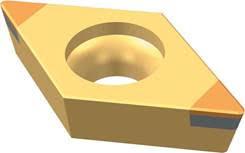
The LACH DIAMOND group developed already in 1974 for the very first time CBN-tipped turning tools for machining hardened steels with a hardness starting from 58-60 Rockwell (HRc).
This technology breakthrough was possible through the development of polycrystalline cutting materials on the basis of cubic boron nitride (CBN).
CBN – even though inferior to diamond in regards to hardness – features a significantly higher thermal stability than diamond (diamond = approx. 700°C / CBN = approx. 1500°C); the reason being that the spark (1000°C) which emerges during steel machining would quickly melt (diffuse) the diamond that consists of carbon.
Until the discovery of polycrystalline CBN cutting materials, hardened steel could only be machined by laborious and time-consuming grinding processes. The slogan „turning instead of grinding“ which was characterised by LACH DIAMOND already in 1974, was a technological sensation even at that time. Long hours of grinding were reduced to a few minutes of turning!
Now, LACH DIAMOND doubles this efficiency by offering an insert with 2 tips: CBN-Duo-power.The development of new CBN cutting materials like the types B610 and B600 used by LACH DIAMOND met the demand of the automotive and component industry for a cutting material with long-term stability for the turning of hardened steels – and this with highest surface qualities of e.g. Ra 0,1 µm.
CBN-Duo-power inserts type B610 or rather B600 are especially recommended for finish turning:
- with interrupted and continuous cut especially in tool steels and case-hardened steels as well as powder-metal alloys
- of components like gears, cardan shafts, valves, belt pulleys and even of brake discs and brake linings and for turning sprayed metal alloys etc.
Contact Details
Related Glossary Terms
- alloys
alloys
Substances having metallic properties and being composed of two or more chemical elements of which at least one is a metal.
- cubic boron nitride ( CBN)
cubic boron nitride ( CBN)
Crystal manufactured from boron nitride under high pressure and temperature. Used to cut hard-to-machine ferrous and nickel-base materials up to 70 HRC. Second hardest material after diamond. See superabrasive tools.
- cubic boron nitride ( CBN)2
cubic boron nitride ( CBN)
Crystal manufactured from boron nitride under high pressure and temperature. Used to cut hard-to-machine ferrous and nickel-base materials up to 70 HRC. Second hardest material after diamond. See superabrasive tools.
- grinding
grinding
Machining operation in which material is removed from the workpiece by a powered abrasive wheel, stone, belt, paste, sheet, compound, slurry, etc. Takes various forms: surface grinding (creates flat and/or squared surfaces); cylindrical grinding (for external cylindrical and tapered shapes, fillets, undercuts, etc.); centerless grinding; chamfering; thread and form grinding; tool and cutter grinding; offhand grinding; lapping and polishing (grinding with extremely fine grits to create ultrasmooth surfaces); honing; and disc grinding.
- hardness
hardness
Hardness is a measure of the resistance of a material to surface indentation or abrasion. There is no absolute scale for hardness. In order to express hardness quantitatively, each type of test has its own scale, which defines hardness. Indentation hardness obtained through static methods is measured by Brinell, Rockwell, Vickers and Knoop tests. Hardness without indentation is measured by a dynamic method, known as the Scleroscope test.
- tool steels
tool steels
Group of alloy steels which, after proper heat treatment, provide the combination of properties required for cutting tool and die applications. The American Iron and Steel Institute divides tool steels into six major categories: water hardening, shock resisting, cold work, hot work, special purpose and high speed.
- turning
turning
Workpiece is held in a chuck, mounted on a face plate or secured between centers and rotated while a cutting tool, normally a single-point tool, is fed into it along its periphery or across its end or face. Takes the form of straight turning (cutting along the periphery of the workpiece); taper turning (creating a taper); step turning (turning different-size diameters on the same work); chamfering (beveling an edge or shoulder); facing (cutting on an end); turning threads (usually external but can be internal); roughing (high-volume metal removal); and finishing (final light cuts). Performed on lathes, turning centers, chucking machines, automatic screw machines and similar machines.
